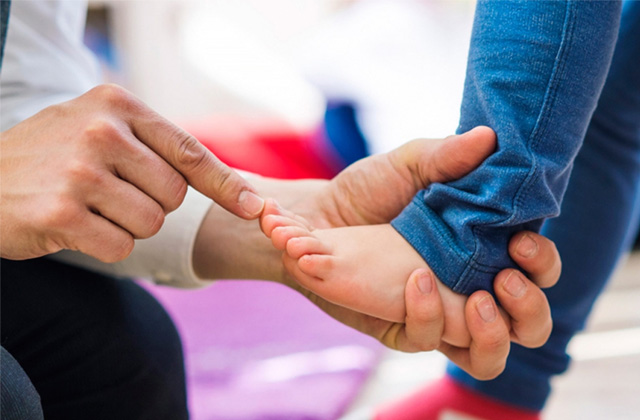Not many people have heard of de Quervain’s tenosynovitis (also known as mother’s wrist or washerwoman’s sprain). But, it’s a fairly common condition, especially among new moms — hence the name.
If you’re struggling with wrist pain as a new mom, de Quervain’s tenosynovitis might be to blame. Read on to learn more about this condition and how you can prevent and treat it.
All You Need to Know About de Quervain’s Tenosynovitis
What is de Quervain’s Tenosynovitis?
This is a condition that affects the tendons (flexible tissues that attach muscle to bone) in the wrist. It occurs when the two tendons located at the base of the thumb become irritated and inflamed.
If the inflammation gets too bad, the tendons can put pressure on the nerves in the wrist and hand and cause symptoms related to carpal tunnel syndrome.
Read More: 11 Effective Ways to Stop Vomiting During Pregnancy
Symptoms of de Quervain’s Tenosynovitis
The primary symptom of de Quervain’s tenosynovitis is the development of pain and/or tenderness at the base of the thumb. Some people also experience pain that radiates up into the forearm.
The pain can come on suddenly, or it may develop gradually. It typically gets worse when you use your wrist, hand, or thumb.
Other common symptoms of de Quervain’s tenosynovitis include:
-
Swelling at the base of the thumb
-
Numbness along the thumb and index finger
-
A “catching” or “popping” feeling when you move your thumb
-
A squeaking sound when you move your thumb
Common Causes of de Quervain’s Tenosynovitis
De Quervain’s tenosynovitis is most commonly associated with chronic overuse of the wrist. New moms have to use their wrists and hands since they’re frequently picking up and holding their babies.
Women who are over the age of 40 or who have injured their wrist in the past are more likely to develop de Quervain’s tenosynovitis than others.
Read More: Week 15 of Pregnancy – Pregnancy Week by Week
How to Prevent de Quervain’s Tenosynovitis
The best way for new moms to prevent this condition is to focus on holding their wrists and hands properly while they’re lifting or holding their babies.
When you’re picking your baby up, avoid lifting them underneath their arms. Instead, scoop them up and lift under their bottom while keeping your hand flat and palm facing up. Make sure your hand, wrist, and elbow all form a straight line.
When you lift your baby up underneath their arms, your index fingers and thumbs take on an “L” shape. This puts pressure on the tendons in the thumb and strains the wrists. When you breastfeed your baby, be sure to put a pillow under your wrist so that the full weight of your baby’s head isn’t being supported in your hand.
Carry your baby in a wearable carrier or push them in a stroller rather than holding them in one arm, too. Holding them this way can strain your wrist, as well as your shoulder.
When you push them in a stroller, be sure to keep your palms flat on top of the handles — this will help you avoid bending and straining your wrists.
How to Treat de Quervain’s Tenosynovitis
If you’re already dealing with the symptoms of de Quervain’s tenosynovitis, it’s important to talk to your doctor to get a proper diagnosis.
Your doctor will perform an examination and a test known as a Finkelstein test. This involves bending your thumb across your palm, bending your fingers down over the thumb, and bending the wrist toward the little finger. If you experience pain on the inside of the wrist, de Quervain’s tenosynovitis is likely the culprit.
Once you’ve been diagnosed, the following treatment options can help relieve your pain and improve your wrist and hand mobility.
-
Alternate between applying ice and heat to the wrist — this will help minimize pain, stiffness, and swelling.
-
Modify your movements (picking up your baby, nursing, etc.) so that you can reduce the amount of strain being placed on your wrist.
-
Wear a splint or brace for a few weeks to give your thumb and wrist a rest — talk to a doctor to make sure you buy the right kind of wrist brace.
-
Use nonsteroidal anti-inflammatory drugs (NSAIDs) like ibuprofen or naproxen as needed to relieve the inflammation.
-
Consider steroid injections or local anesthetic to relieve pain and inflammation that won’t go away with the help of other measures.
It’s also helpful to work with a physical or occupational therapist. They can show you exercises to improve your mobility and strengthen the muscles in the hands and wrists. This will help prevent irritation and inflammation in the future.
In some cases, surgery is required to correct the inflammation causing de Quervain’s tenosynovitis. However, most people are able to relieve their pain and improve their mobility without such drastic measures.
Conclusion
De Quervain’s tenosynovitis is common among women, especially mothers. But, it’s not an inevitable part of becoming a parent.
If your wrist is feeling fine, these prevention tips can help you maintain that feeling. If you are dealing with pain, talk to your doctor and implement the treatment strategies mentioned above to help relieve your discomfort and stop the condition from getting worse.
Read More: Can A Woman With Osteoporosis Give Birth?













